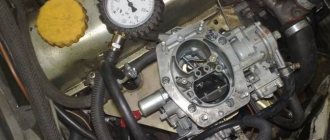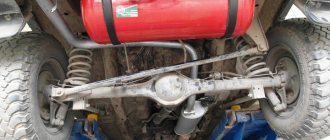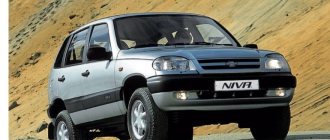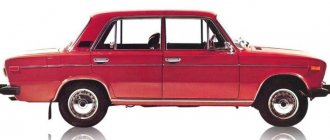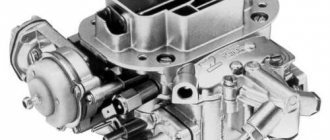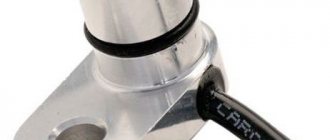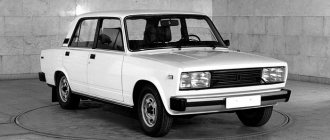What can we say about the appetites of the taiga?
A type of SUV under the tempting name “Taiga” is especially preferred among fishermen and hunters.
Of course, fuel consumption will largely be related to driving style, time of year, and engine modification. The five-door version will require up to 13 liters in city mode, up to 11 in mixed mode and 9.5 liters on the highways. In cases where the carburetor settings are correct, the reason for the increase in fuel consumption may be increased wear of the piston group parts.
Then you can see what the gasoline consumption will be on various modifications of the Lada 4x4, better known under the Niva brand, according to the manufacturer.
| Modification | VAZ-2121 (1.6 75 hp carburetor) | VAZ-21213 (1.7 carburetor 76 hp) | VAZ-21214 (1.7 80 hp injector) | VAZ-2131 (1.8 82 hp carburetor) | VAZ-2131 (1.7 80 hp injector) |
| Gasoline consumption liters per 100 km (l/100 km) | |||||
| Urban cycle | 13,4 | 11,5 | 11,2 | 12,3 | 12,2 |
| Country cycle | 10,8 | 8,3 | 8,2 | 9,4 | 9,2 |
| Mixed cycle | 13,1 | 11.2 | 10,2 | 12,1 | 11,9 |
Technical functionality
The technical characteristics of the VAZ 2131 in terms of fuel consumption are as follows - the volume of fuel used is measured in several locations. There are three standard modes, which provide factory data on the fuel consumption of the machine. For the model under consideration, there are the following technical characteristics:
| Engine | Consumption (highway) | Consumption (city) | Consumption (mixed cycle) |
| 1.8 | 10 l/100 km | 15 l/100 km | 12.3 l/100 km |
| 1.7 | 9.5 l/100 km | 12.5 l/100 km | 11 l/100 km |
City mode for the Niva 2131 five-door model (engine 1800, injector) is the most energy-intensive. Although in general, fuel consumption on the Niva 2131 injector is quite acceptable for trips outside the city.
Chevrolet Niva
Chevrolet Niva is a Russian all-wheel drive SUV jointly produced by AvtoVAZ and the American General Motors. It went into mass production in 2002, and in 2009 it underwent a noticeable restyling. So far, only the first generation of this off-road vehicle can be seen on sale, although for many years there has been talk of launching a second one.
Fuel consumption for the Chevrolet Niva differs depending on the engine modification; below is the consumption in mixed mode for each of the existing modifications:
Chevrolet Niva 2002-2009:
- 1.7 l, 80 l. With. – 10.9 l/100 km;
- 1.8 l, 125 l. With. – 10-10.1 l/100 km.
All modifications run on AI-92 gasoline.
Chevrolet Niva 2009 – our days (restyling):
- 1.7 l, 80 l. With. (AI-92) – 10.2 l/100 km;
- 1.7 l, 80 l. With. (Regular gasoline: AI-92, AI-95) - 10.8 l/100 km.
What is the fuel consumption of the Chevrolet Niva in different road conditions? According to the passport data, in the urban cycle the normal consumption is 14.1 liters per “hundred”, and on a free highway – only 8.8 liters. But according to reviews from owners, it is unlikely to meet 8.8 liters on the highway: more realistic figures are 9-10 liters of gasoline.
Design features • Consumption features
The front wheels use an independent suspension with a multi-link design, coil springs and anti-roll bar, and the rear wheels have a dependent suspension with a rigid torsion beam, telescopic shock absorbers and coil springs. Working brake system Hydraulic, with a vacuum booster, dual-circuit Front brake Disc, non-ventilated, with a movable caliper, three-piston Rear brake Drum, with automatic adjustment of the gap between the shoes and the drum Parking brake With a cable drive to the rear brake shoes.
| Car modifications | 21213 1.7 | 21214 1.7i | 21217 1.6 |
| Engine | |||
| Engine location | Front longitudinal | ||
| Engine capacity | 1690 cm3 | 1569 cm3 | |
| Number of cylinders / Valves per cylinder | 4 / 2 | ||
| Piston stroke | 82 mm | 79 mm | |
| Cylinder diameter | 80 | ||
| Compression ratio | 9.3 | 8.5 | |
| Supply system | Carburetor | Distributed injection | Carburetor |
| Power (hp/rpm) | 79 / 5400 | 81 / 5000 | 73 / 5400 |
| Torque (Nm/rpm) | 130 / 3400 | 128 / 4000 | 114 / 3400 |
| Fuel type | AI-92 | AI-95 | AI-92 |
| Transmission | |||
| Wheel formula / drive wheels | 4X4 / permanent all-wheel drive | ||
| Transmission | mechanical | ||
| Number of gears | 5 | ||
| Transfers of the Republic of Kazakhstan | 1 highest, 1 lowest | ||
| Steering | |||
| Type | Worm gear | ||
| Amplifier | |||
| Brake system | |||
| Front brakes | Disk | ||
| Rear brakes | Drums | ||
| Suspension | |||
| Front suspension type | Helical spring | ||
| Rear suspension type | Helical spring | ||
| Body | |||
| Body type / number of doors | Station wagon / 3 | ||
| Number of seats | 5 | ||
| Length | 3720 mm | ||
| Width | 1680 mm | ||
| Height | 1640 mm | ||
| Wheelbase | 2200 mm | ||
| Front wheel track, mm | 1430 mm | ||
| Rear wheel track, mm | 1400 mm | ||
| Clearance | 220 mm | ||
| Trunk volume | 265 / 980 | ||
| Curb weight | 1210 | ||
| Permissible weight | 1610 | ||
| Performance characteristics | |||
| Acceleration time to 100 km/h | 19 s | 17 s | 23 s |
| Maximum speed | 137 km/h | 132 km/h | |
| Tire size | R16 175 / 80 | ||
| Fuel consumption urban cycle (l/100 km) | 9,7 | 10,6 | 11 |
| Fuel consumption extra-urban (l/100 km) | 8,3 | 8,6 | |
| Volume of the tank | 43 | ||
VAZ 21213
Initially it was supposed to be called “Taiga”, VAZ-21213 - a restyling of the classic model. The rear part of the body has undergone changes: the lights and the shape of the third door have been redesigned, and the loading height has been reduced. The power unit was also updated - now it was a 1.7-liter engine with a Solex carburetor with a capacity of 82.8 hp. With. and a torque of 125 Nm, characterized by increased torque.
In addition to the listed changes and improvements, there were a number of other innovations affecting the exterior and interior, as well as the technical characteristics of the car. But the main thing is that thanks to a five-speed manual transmission and axle gearboxes with a 3.9 final drive, in combination with a more powerful engine, the manufacturer managed to slightly reduce the fuel consumption of the Niva to:
- 8.3 l/100 km on the highway;
- 11.5 l/100 km in city traffic;
- 9.1 l/100 km in mixed mode.
There is also an injection version of the 1.7 liter engine with a capacity of 83 hp. With. (Niva-21214) with similar other characteristics, but gasoline consumption per 100 km is different:
- 8.3 liters on a free highway;
- 11.2 l in the urban cycle;
- 9.7 l in mixed mode.
It is worth noting: before the Niva-21213 fully entered the series, a transitional batch was released with a standard engine from 2121.
Dimensions, weight, load capacity
From the start of production, the VAZ-21310 model, the technical characteristics of which were constantly being improved, was equipped with a gasoline carburetor engine brand 21213 with the following characteristics. What I like about the car is that it really has a very spacious interior, like a V8 seat, but sitting behind the wheel is much more comfortable than in a chisel, I still don’t understand why.
VAZ 2131
Niva-2131, also known as 5D, was released in the mid-90s as a more spacious version of the previous model. The body became five-door, and for this purpose it was lengthened by 500 mm using a central insert, which is why the car was popularly nicknamed “Crocodile”. This was also facilitated by the green color, which was often used for this version of the car at the manufacturer.
The wheelbase and the amount of space inside the cabin have changed. Thus, the distance between the front and rear seats has increased by 125 mm. Accordingly, the weight of the vehicle has increased and, as a direct consequence, fuel consumption. On VAZ-2131 it averaged:
- 9.8 l/100 km on a free highway;
- 13.7 l/100 km when driving on busy city streets;
- 12 l/100 km in mixed mode.
But the enlarged body made it possible to make a larger fuel tank (65 l). The dynamics of the car remained approximately the same, at the level of 2121. The engine in the basic configuration is a 1.7 liter carburetor with a capacity of 80 hp. pp., working with manual transmission. There is a modification with an 83-horsepower injection power unit, which has slightly lower gas consumption:
- 9.8 l/100 km on the highway;
- 13.2 l/100 km in the city;
- 10.6 l, 100 km in mixed mode.
Later, the developers became concerned with improving the characteristics, as a result of which a version of the VAZ-2131 with a 1.8 liter, 84 hp engine rolled off the production line. With. and a torque of 132 Nm. However, this step again increased the “appetites” and the Niva’s consumption per 100 km for this engine is, under average conditions:
- 12 liters on a free highway;
- 13.8 l in the urban cycle;
- 13.1 liters on average.
This was the price to pay for some increased cross-country ability and improved dynamics.
Option 2 of 4: Fuel Saving: Key Points
| Niva fuel consumption. Table with fuel consumption for Niva. Acceptable fuel consumption of the Niva To replace the part, you need to drain the antifreeze, then unscrew all the bolts on the pipes from the thermostat clamps, remove the pipes and remove the element from under the hood. Thanks to nipple extensions, it is possible to inflate the wheels without first removing the caps, however, immediately before inflating, you need to check their condition for leaks or obstructions. |
| Fuel consumption per 100 km Niva: Chevrolet, 2131, 2121, 21213 This is, first of all, high gasoline consumption on average 13-14 liters per 100 km on the highway in the summer, gasoline consumption is quite high, because according to the passport 12 liters in the city, and in in reality about 13 liters. According to factory data, fuel consumption in urban conditions did not exceed 13.7 liters, which is only 0.3 liters more than the standards for an SUV with a short wheelbase. |
- The terrain through which the vehicle is moving;
- Wear of engine parts;
- Fuel quality;
- Ambient temperature;
- Turning on additional electrical equipment (heated glass, air conditioning), etc.;
How to reduce fuel consumption on a Niva • UAZ or Niva which is better, car characteristics and features.
VAZ-2121
Several types of 4-cylinder engines were offered for cars:
- A 1.6-liter carburetor unit producing 80 hp was standard. With. (later the value was reduced to 75 forces due to the introduction of a new measurement standard), borrowed from the VAZ-2106 sedan. The control gasoline consumption is set at 9.9 liters at a speed of 80 km/h. When accelerating to 120 km/h, the standard increased to 13.1 liters, and in urban conditions the engine required 13.4 liters. The cars were equipped with a 4-speed gearbox without an overdrive in the early 90s. cars with a 5-speed transmission appeared.
- For a number of European countries, a model was produced with a 69-horsepower 1.3-liter VAZ-21211 engine and a gearbox with changed gear ratios. The cars were characterized by reduced dynamic capabilities, and consumption on the highway at 90 km/h and in the city was 10.6 and 13.0 liters.
- In the early 90s. The VAZ-21219 model was produced with a 1.7-liter carburetor engine producing 81 hp. With. and a 5-speed gearbox.
Where does the increased consumption come from?
There are plenty of reasons why the Niva’s fuel consumption increases significantly. These include poor roads and poor fuel quality, the effects of long cold spells and harsh operating conditions. But gasoline consumption due to the first 2 reasons fits well into the figure of 13 liters. Those motorists who drive mostly off-road or with heavy loads are well aware of fuel costs in such conditions and do not complain about consumption.
Unlike the VAZ 21213, the Chevrolet Niva does not deviate too much from its passport specifications. Here the reason lies in a different body shape with better aerodynamic performance and well-chosen transmission ratios. If we discard the general factors that affect fuel consumption, then many individual factors remain, depending only on the car enthusiast:
- aggressive driving style on any type of road;
- refueling with fuel with insufficient octane number;
- driving with a roof rack installed and other elements that impair the aerodynamics of the body;
- intervention in the design of a car for the purpose of tuning;
- improper maintenance and care of the machine.
If everything is clear with the aggressive mode and the wrong gasoline, then clarification is required about the roof rack. Air resistance when driving a car does not increase proportionally to speed, but much more strongly. Take for example 2 speeds - 60 and 120 km/h - differing by 2 times. When moving from 60 to 120 km/h, air resistance increases not by 2 times, but by 6 times. Hence the fuel consumption when driving with a trunk, additional headlights on the roof and mirrors.
Like any car, the Niva 21213 needs to be serviced on time and the functionality of the components checked if there is a hint of a malfunction.
For example, if the air damper position sensor or lambda probe fails, the car will drive, but the fuel consumption will also increase. Old spark plugs, which are long overdue for replacement, will have the same effect.
Injection
The use of an injection system allows you to continuously adjust the mixture composition, reducing exhaust emissions and fuel consumption. During suburban operation of cars, fuel consumption is up to 8.5 liters; in dense traffic inside a populated area, engines burn up to 14 liters, corresponding to their carburetor counterparts.
When driving through wetlands or loose soil, cars require from 12 to 20 liters of fuel (efficiency in off-road conditions is not regulated by the factory).
Injection engine type.
How to save on fuel for a field owner
- try to use various electrical equipment inside the car less often, for example, air conditioning, heated seats, lighting, playing music, etc.;
- By changing your driving style and eliminating sudden acceleration, you will reduce instantaneous consumption. The optimal speed should be 80–90 km/h;
- It is advisable to drive more on asphalt roads, since off-road the car will always “eat” more;
- Carry out engine diagnostics to understand if there are any malfunctions that affect actual fuel consumption.
Also interesting: Lada Vision 4x4 - new Niva from AvtoVAZ
What is the fuel consumption of Lada 4×4 (VAZ 2121 and VAZ 2131)
November 17, 2022 Lada.Online 259 173
Before buying a car, you should understand what costs will be required to maintain it. Therefore, the manufacturer in the technical specifications indicates fuel consumption data in liters per 100 km. Let's find out what numbers are indicated in the Lada 4x4 documentation and what values are found in practice during the operation of an SUV.
On the official website, AVTOVAZ indicates the following fuel consumption per 100 km for Lada 4×4:
- Urban cycle - 12.1 l/100km
- Extra-urban cycle - 8.3 l/100km
- Mixed cycle - 10 l/100km
These values are the same for all Lada 4x4 injectors (3-door, 5-door and “Urban”).
The manufacturer notes that fuel consumption data was determined under standardized conditions using special measuring equipment, in accordance with the requirements of GOST R41.101–99 (UNECE Rules No. 101). Used to compare cars from different automakers. They are not an operational standard.
Currently, the plant does not produce Lada with a carburetor engine, so the figures were found in the operating, maintenance and repair manual for the Lada 4×4 car for 2005. There is a detailed table with fuel consumption for this SUV:
| Options | VAZ-2129 | VAZ-2129-01 | VAZ-2130 | VAZ-2131 | VAZ-21312 | VAZ-2131-01 | VAZ-21312-01 |
| Engine | VAZ-21213 | VAZ-21213 | VAZ-21213 | VAZ-21213 | VAZ-2130 | VAZ-21213 | VAZ-2130 |
| Gasoline consumption per 100 km when driving in top gear, no more than, l | |||||||
| at a speed of 90 km/h | 10,3 | 10,3 | 10,3 | 9,1 | 9,3 | 9,1 | 9,3 |
| at a speed of 120 km/h | 11,8 | 11,8 | 11,8 | 12,1 | 12,3 | 12,1 | 12,3 |
| during urban driving cycle | 12,3 | 12,3 | 12,3 | 11,1 | 11,9 | 11,1 | 11,9 |
We also provide data on fuel consumption for different types of engines from Wikipedia:
- VAZ-2121 (carburetor): 10.8-13.4 l/100 km
- VAZ-21213 (carburetor): 8.3-11.5 l/100 km
- VAZ-21214 (injector): 8-9.1 l/100 km
Thus, fuel consumption on a Lada 4x4 (injector) is slightly less than with a carburetor. It is worth noting that reviews from owners of this SUV indicate that in practice the numbers may be higher. It is not uncommon to see fuel consumption of 14 l/100 km or even 15 l/100 km on a Lada 4x4.
How to reduce fuel consumption:
- Change your driving style, make acceleration smoother, and do not exceed speeds above 80..90 km/h.
- Drive more often on flat roads. On off-road, fuel consumption is significantly higher.
- Use additional electrical equipment of the car less often. For example, air conditioning, heated seats, etc.
- There may be problems with the engine. Perform diagnostics and troubleshoot problems.
- Fuel consumption on AI95 is less than on AI92.
It is worth remembering that high or increased fuel consumption is observed in winter, when the engine warms up for some time before driving.
What is the average fuel consumption on your Lada 4x4 SUV? Do you have any tips to help reduce these numbers? Let us remind you that fuel consumption also depends on the type of gasoline, so the majority of owners recommend using AI95.
Keywords: 4x4 power system | 4x4 engine
Share on social networks:
Found an error? Select it and press Ctrl Enter..
Guests cannot leave comments in the news, please log in.
Option 4 of 4: How to plan a trip?. Basic moments
| Lada 212140 fuel consumption per 100 km According to factory data, fuel consumption in urban conditions did not exceed 13.7 liters, which is only 0.3 liters more than the standards for an SUV with a short wheelbase. The plastic in the cabin is ordinary, I never understood why many people value soft plastic and a panel, it’s easier for the owner, wipe it with a cloth and no dry cleaning or vacuum cleaner is required. |
- Condition of spark plugs and high-voltage wires. Carbon deposits on the electrodes or breakdown of insulation impairs the spark. As a result, the fuel burns incompletely or too slowly.
- Dirty injectors. Plaque in the jets or a faulty solenoid valve prevents the creation of the optimal concentration of the fuel-air mixture.
- Throttle. Problems with the opening and closing of the damper change the composition of the mixture in the combustion chambers. This worsens the traction and efficiency of the motor.
- Filter status. A clogged air filter prevents sufficient oxygen from being delivered to the combustion chambers. Faulty fuel filters cause interruptions in engine operation, which negatively affects fuel consumption.
- Tire pressure, condition of wheel bearings and transmission, wheel alignment angles. Rolling resistance depends on these parameters. Half-flat tires or improper wheel alignment can increase gas mileage by 10-20%.
- Thermostat. A valve frozen in the open position does not allow the engine to warm up to operating temperature. In the cold season, this increases fuel consumption by 25%; in the warm season, the excess consumption will be slightly lower.
- Catalyst. A serviceable part does not greatly affect efficiency. But over time, the catalyst honeycomb becomes clogged and impedes the passage of exhaust gases. This reduces the efficiency of the engine and can even lead to problems starting it. There are two ways to solve the problem: the correct way is to replace the part, the budgetary and non-environmental way is to cut out the catalyst and weld a piece of pipe in its place.
Carburetor
Gasoline consumption when using a carburetor depends on the adjustments and technical condition of the unit. Damage or clogging of the jets leads to uneven mixture formation and increased fuel costs.
According to owner reviews, the minimum consumption on the highway is 9 liters (when the mixture is lean and the power of the power unit is simultaneously reduced).
In urban conditions, engines burn from 12 to 14 liters (in winter the parameter increases due to prolonged warming up), and on off-road fuel costs reach up to 20 liters and depend on road conditions and the skill of the driver.
When using a carburetor, fuel consumption is 9 liters on the highway.
What increases gasoline consumption on Niva series cars?
Fuel consumption for the Niva 2131 is 16.5 liters in urban conditions, 12.1 liters for the mixed version and 9.7 liters for the highway. This figure can hardly be significantly reduced, and it easily increases due to improper operation of any vehicle, including:
- Overload. Not all drivers remove unnecessary items from the trunk or remove roof racks, which increases fuel consumption. You also need to take into account that car body kits, for example, a guard with protection, can weigh more than tens of kg, which also makes the design heavier.
Disadvantages of the carburetor
The main disadvantages include the following:
- This engine is unreliable. That is, almost every season it is necessary to service the carburetor and adjust it.
- Such a motor is highly dependent on air temperature. Mostly problems arise in winter with such an engine. For example, if you overfill the spark plugs, it will be impossible to start the car. To do this, you will have to unscrew them and dry them. In addition, in winter the float often gets stuck, this is due to condensation. In the summer, many Niva owners with a carburetor engine are faced with such a problem as an overheated fuel pump.
- Low productivity. To increase the engine's potential, it is necessary to spin the engine to high speeds.
- Very high fuel consumption.
It is worth noting that, despite the fact that this power system is quite simple and repairable, it requires special attention. Many car owners should prepare in advance for the fact that they will have to rebuild the carburetor several times every year.
General information about the Niva model car: technical characteristics
The Lada Niva is equipped with an all-metal monocoque body with additional reinforcements that increase torsional rigidity.
At the front there is an independent wishbone suspension with stabilizer, complemented by double-acting shock absorbers and coil springs.
At the rear, an axle is used, equipped with a dependent wishbone suspension with shock absorbers and springs. The chassis concept has remained unchanged since 1977, but the introduction of improved components has improved the reliability of the suspension.
The engine is installed longitudinally in the engine compartment. To distribute torque between the wheels, a transfer case with a low row is used.
Early series cars had a 4-speed manual transmission, later a 5-speed transmission appeared. The fuel supply is located in a metal tank with a capacity of 42 (model 21213) to 65 liters (modification 2131).
Pick-up trucks and cash-in-transit vehicles were produced on the basis of Niva. By mid-2022, the plant will offer a standard 4x4 version of the vehicle and a 4x4 Urban model with voluminous plastic bumpers.
The Chevrolet Niva model features a new body designed to carry 5 passengers. The interior trim differs from the interior of the classic Niva. Under the hood there is an 80-horsepower VAZ-2123 engine with a 5-speed gearbox.
Depending on the year of manufacture, cars may be equipped with air conditioning, hydraulic power steering and front airbags. SUVs with a 1.8-liter Opel engine developing 125 hp were assembled in small batches. With.
The table shows the comparative technical parameters of the VAZ-2131 and 2123 cars.
| Parameter | VAZ-2131 | VAZ-2123 Chevrolet Niva |
| Length, mm | 4240 | 4056 |
| Width, mm | 1680 | 1800 |
| Height, mm | 1640 | 1690 |
| Wheelbase, mm | 2700 | 2450 |
| Ground clearance, mm | 200 | 220 |
| Maximum speed, km/h | 137 | 140 |
| Acceleration time to 100 km/h, seconds | 19 | 19 |
| Curb weight, kg | 1425 | 1485 |
| Permissible total weight, kg | 1850 | 1860 |
Modifications Dimensions ground clearance
| Lada 213100 Lada 4x4 technical specifications. technical characteristics of the car Niva 2131. Lada 213100 Lada 4x4 technical characteristics In addition to the standard equipment, installation of a spare wheel mounting bracket on the trunk door is provided, and the spare wheel is placed in a special case. , 5MT Body Wheel formula driving wheels 4 x 4 all Engine location front longitudinal Body type number of doors station wagon 5 Number of seats 5 Length width height, mm 4240 1680 1640. |
| Lada 213100 Lada 4x4 technical specifications. Technical characteristics of the car Niva 2131. Lada 213100 Lada 4x4 technical characteristics Thanks to the front wheels installed at certain angles relative to the body parts and suspension, this car has good stability and controllability. Despite the absence of a large number of modern assistants, high ground clearance and all-wheel drive with a locked center differential play a dominant role when passing snow-covered obstacles and deep mud puddles. |
Choice of color and configuration • According to the operating manual, the maximum engine oil consumption is 0.7 liters per 1000 km.
Features of gas consumption when driving
The plant has not officially installed gas equipment on Niva cars; modifications are carried out by the owners. It should be taken into account that the installation of a propane-butane mixture supply system requires making marks in the documents.
If the driver does not have permission, a fine is imposed or a ban on further operation of the car is issued. The fuel cylinder is installed in the luggage compartment, reducing its already small volume. Owners are forced to carry cargo on the external trunk, which leads to increased fuel consumption due to increasing resistance.
Gas consumption depends on the operating mode and modifications made to the vehicle design. According to drivers, the consumption of liquefied gas during highway driving is 12-13 liters per 100 km, and in the city the parameter reaches 15-16 liters.
Some owners install equipment for supplying compressed methane (gas reserve in 2 cylinders is 16 m³). The car can travel on the highway up to 200 km, in the city the gas runs out after 160-170 km (consumption in mixed mode is about 9 m³).
Also interesting: Which is better: Patriot, Duster or Chevy Niva? UAZ won the hard facts, but car enthusiasts called it a coffin for losers
Niva with HBO.
Niva's fuel consumption depends on the driving cycle.
The injector on 21214 has the following operating scheme: from vehicle components, a number of sensors receive data on air flow, crankshaft movement, coolant temperature, engine detonation, fuel consumption, voltage in the on-board network, etc. The fuel consumption of the VAZ 21213 per 100 km also depends on is influenced by the speed at which the car moves, the year of its manufacture and many other factors, from the condition of the road surface, the correct selection of car tires and their wear, to the driving experience of the driver himself.
Gasoline consumption
As a result, Niva Travel differs little in appetite from its ancestors half a century ago:
- on the highway it is 8.5 - 10 l/100 km;
- in the city / - 12l/100 km.
This is real consumption according to reviews from owners, but it should be borne in mind that data on instantaneous consumption is not displayed on the Niva’s instrument panel, so the figures are approximate. But, oddly enough, they agree with the factory ones (usually automakers try to underestimate the data).
Official fuel efficiency parameters of NivaTravel, l/100 km
| In the city | 13,4 |
| On the highway | 8,5 |
| Mixed (combined) cycle | 10,2 |
Recommended fuel is AI-95 gasoline.
It’s pointless to discuss off-road consumption; if you’re slipping knee-deep in mud, you can burn more than a liter per kilometer, but on such “roads” the priority will be to get to the goal, and what kind of consumption is the tenth thing and interesting only in terms of “will there be enough gasoline at all?”
Fuel consumption Lada 4×4 2121 Niva 1977, jeep/suv 3 doors, 1st generation
| Engine capacity | Power | Transmission | Drive unit | Fuel | Consumption |
| 1.7 l | 83 hp | Manual transmission | four-wheel drive (4WD) | Gasoline AI-95 | 9,9 |
| 1.7 l | 80 hp | Manual transmission | four-wheel drive (4WD) | Gasoline AI-95 | 9,9 |
| 1.6 l | 80 hp | Manual transmission | four-wheel drive (4WD) | Gasoline AI-92 | 10,0 |
| 1.6 l | 73 hp | Manual transmission | four-wheel drive (4WD) | Gasoline AI-92 | 10,0 |
| 1.7 l | 79 hp | Manual transmission | four-wheel drive (4WD) | Gasoline AI-92 | 10,5 |
| 1.7 l | 83 hp | Manual transmission | four-wheel drive (4WD) | Gasoline AI-95 | 12,0 |
How much do injection and carburetor engines consume?
Fuel consumption on a Niva with an injector engine will be slightly less than on a carburetor analogue. One of the most popular power units (or rather, almost the only one) is the 1.7 liter engine. On the highway it takes relatively little, for such a vehicle - only 9-10 liters. Despite the relatively small volume of the gas tank, it will be enough for long country trips up to 400 kilometers.
If you use primarily 5th gear, then fuel consumption can be reduced to an even smaller value - 8 liters. This is facilitated by an injection engine, which is more economical compared to a carburetor engine. However, urban driving mode will be wasteful for the Niva owner, since here you can often spend 13 or 14 liters “per hundred”.
Basic methods
The actual fuel consumption of the Niva 2131 can be reduced due to the weight of the car.
You can get rid of unnecessary parts of the vase, which provide comfort, but take away gasoline. Driving style is an important factor influencing the engine's use of gasoline: the more extreme, harsh driving style, the more fuel will be consumed. Change your driving style to a more relaxed one, and you will pay less for gasoline in the face of rising prices.
Installing an injector is the most effective way to reduce fuel consumption, the only problem is that if the injector is already installed, the situation will not change. Gasoline consumption on a Niva leads to the data indicated above, that is, without them, the Niva will “eat up” much more fuel.
Factors affecting gasoline consumption
Every car owner cares about how much fuel his car consumes. In recent years, the race for economy and environmental friendliness has led to the emergence of a large number of cars with a really low “appetite”. Therefore, the figure of 6 liters per 100 km has long been no longer the subject of dreams, and 10 liters per “hundred” has become a psychologically important mark, consumption above which raises natural questions.
For Niva cars, consumption from 11 to 14 liters is considered quite normal, anything after 6-8 liters for front-wheel drive seems like a big waste. But you need to understand that the Niva is a full-fledged all-wheel drive and has high cross-country ability. But sometimes consumption exceeds acceptable standards - there can be many reasons for this.
For example, many engines based on a fuel injection system reduce their efficiency when used incorrectly, and this leads to increased consumption. Here are the main reasons why the engine burns fuel more actively:
- Low quality of gasoline itself and, as a result, malfunction of fuel filters.
- Fuel system contamination.
- Reduced compression in the engine.
- Significant wear of piston rings, pistons and cylinder block.
- Incorrect injector setting.
It is also worth highlighting the impact of air temperature, weather conditions and driving style on fuel costs. Sharp braking and acceleration lead to increased wastage of gasoline, and in winter, consumption can increase significantly, up to two times. This can be caused by low tire pressure in the cold and icy roads, which causes the wheels to grind at the start.
What else can you win?
The more revolutions are made, the more fuel the car consumes; VAZ 2131 gasoline consumption per 100 km can be reduced if you drive at lower speeds. At the same time, on our roads low speeds can be dangerous, the best way out of this situation is to start driving smoothly and slowly reach medium speeds, and then move like that, this does not mean that you need to drive at a speed of 40 km/h - just you need to do everything in moderation.
It is better not to use an automatic transmission if you want to reduce gasoline consumption standards; mechanized control allows you to control the gasoline in the tank, so it is better to use a manual transmission.
Gasoline consumption factors on the highway
On the highway, the main consumption factors will be:
- Aerodynamic air resistance. To increase cross-country ability, the ground clearance was raised, but at the same time the silhouette of the car became higher. This means that when moving, it has to “push” more air, wasting gasoline on it.
- Transmission losses. All-wheel drive involves increasing the transmission elements. The rotation of each requires energy, although the efficiency of a single bearing can exceed 0.99, there are many of them, and the total losses become noticeable.
In Soviet times, advanced breeders chased SKF bearings as higher quality and more durable, trying to switch to imported ones whenever possible.
At the same time, fuel consumption also decreased slightly, although few people were interested in this at the time. A separate song handout. Moreover, the song is in the literal sense of the word: its howling has infuriated more than one generation of drivers, and even now sometimes music is selected for the Niva with the expectation “to drown out the transfer case.” At that time, this state of affairs was due to a shortage of specific precision metal-cutting machines, forcing designers to increase tolerances, designing something that could be mass-produced using existing technological equipment. The periodic whining of modern transfer cases is more difficult to explain, fortunately complex additives have appeared in transmission oil, which significantly reduce the severity of the problem of gear break-in. But this is not just noise, but a symptom of increased friction losses and minus efficiency. 3. Another factor is tires. It is almost impossible to combine good grip properties on snow and mud and low rolling friction losses, including internal ones (hysteresis). What you have to sacrifice in the case of an SUV is clear.
Problems and solution
It may surprise you, but even open windows increase fuel consumption, especially in city conditions. It’s quite simple to explain: the aerodynamic properties of the car are somewhat reduced, which is why the air resistance in the Niva’s cabin increases, as a result of which the need for fuel is much greater.
- reducing the friction force in the engine will reduce fuel consumption;
- this is not difficult to do: you just need to regularly lubricate the parts with engine oil;
- the oil must be of high quality, otherwise there will be no effect;
- It is better to use high viscosity motor oil;
- increasing the pressure in Niva tires will reduce gasoline costs;
- the same laws of physics apply here: pumped by no more than 0.3 atm. tires will help reduce speed and friction with the road.
One of the best developments of the domestic automobile industry, Niva, came off the VAZ assembly line in 1977 and is still in stable demand. According to the modern classification, this car belongs to the crossovers, since it has a monocoque body, but in terms of cross-country ability it is not inferior to any “purebred” frame SUV. At the same time, the fuel consumption of the Niva is much lower than that of a car with similar functionality. Among its advantages are:
- highest cross-country ability;
- maintainability;
- affordable price;
- reliable carburetor and injection engines;
- all-wheel drive transmission.
Owner reviews
- Ivan, Nikolaev. VAZ 2121 is one of the best SUVs, especially when you consider the cost of the car. It is suitable not only for outdoor trips, but also for city driving. I have owned the car since 2002, the 1.7 engine with a carburetor is very reliable, 80 horsepower is enough to pull the car well off-road and on the highway. Average consumption is about 12 liters per hundred, but you can save money by installing gas, which is what I’m thinking about now.
- Nikolay Chelyabinsk. I have been driving a VAZ 2121 for more than 10 years and have no intention of changing it - it is an ideal second car for fishing and hunting trips. The 1.6 engine is not very dynamic, but my average speed does not exceed 90 km/h. But in any mud it pulls so well that even the UAZ Patriot cannot keep up with it. I'm not even talking about fashionable foreign cars. What is the fuel consumption of my Niva? About 14 liters, which is quite normal for such a car.
- Anatoly, Volokolamsk. I bought a Niva in the 2121 body in 2022, with a mileage of 80 thousand km. Since then I have not left the cabin either in winter or in summer. In terms of cross-country ability, this is simply a standard - no car can compare with it. The 1.7 liter engine consumes about 13 liters in a circle, both AI 92 and AI 95 eat with equal appetite. I would also like to note a fairly comfortable interior, but the trunk is a bit small, but this is nitpicking.
- Sergey, Ufa. I have a VAZ 21213 with a 1.7 engine and a manual transmission, which I inherited from my grandfather. He took great care of the car, I try not to let him down and also monitor its condition. I change the oil and filters myself, carry out maintenance and minor repairs, and don’t break the car off-road or in deep snow. Consumption at speeds of 65-80 fuel consumption on the VAZ 21213 is about 11 liters per hundred.
- Valery, Peter. I bought the car from the secondary market and chose an inexpensive, practical modification with a 1.6 engine. The car is surprisingly playful in the city, but off-road, in my opinion, there is not enough traction. The engine regularly consumes both 92 and 95 gasoline, consumption is about 12 liters per 100 km.
- Alexey, Chernigov. I own a Lada 4x4 with a 1.7 carburetor engine. All-wheel drive and a manual transmission with locking are an excellent option for off-road use. Maybe I came across such a car, but the reliability leaves much to be desired, however, repairs are inexpensive. The power of 80 horses is enough to drive equally confidently in city mode, on the highway, on country roads and off-road.
- Bogdan, Lipetsk. I'm an avid fisherman, so I can't do without a good SUV. I chose the VAZ 2121 not only because of the price, but also because of its excellent cross-country ability and I don’t regret it. If necessary, I repair my Niva myself, the consumption was about 13 liters, after installing gas it increased to 17 kg per hundred, but in terms of money it is much more economical.
- Denis, Kharkov. Over the six years of owning the VAZ 2121, I have driven more than 120 thousand km, I have absolutely no complaints. Yes, the suspension and transmission require regular repairs, but I do everything myself, and spare parts are quite affordable. I change worn out parts in advance, so I have never gotten stuck even on severe off-road conditions. The 1.7 carburetor engine with 80 horsepower pulls well, fuel consumption on my Niva 2121 does not exceed 13 liters.
- Nikolay, Saratov. I have a 2000 Niva with a 1.7 engine with a carburetor. I have been driving it for more than 10 years, there are complaints about reliability, but with straight hands it is easily repaired and will never let its owner down. Consumption on the highway is 9 liters, in the city about 14.
- Grigory, Khanty-Mansiysk. Over the 8 years of owning my Niva, I have driven almost 200 thousand km. The car is comfortable, passable, quite reliable, ideal for going fishing and hunting. It doesn't matter if it's hot, rainy, muddy or snowy, it will get you where you need to go. Now the Xray Lada has appeared, but, according to reviews, it does not reach the performance of the VAZ 2121 on off-road. Therefore, I’m not going to change it; the consumption of 14 liters per hundred, even in severe frosts, completely satisfies me.
- Alexander, Moscow. I bought the car in 2003 specifically for fishing trips. I immediately liked the car for its comfort, cross-country ability, and torquey 1.7 engine with 80 horses. Relative disadvantages include fragility and a small trunk, which, however, is quite enough for me. The average consumption rate is 12 liters in summer and 13 in winter.
- Valentin, Leningrad region. Despite the monocoque body, the Niva is one of the best SUVs I know. The 1.7 injection engine is powerful and reliable, consuming no more than 12 liters per 100 km. The manual transmission is designed for off-road driving, which the car copes with very well. The car runs great on 92 gasoline - this is another advantage.
- Svyatoslav, Pskov. I have a Niva 2121, I’ve already driven 150 thousand km on it, and I consider it the best off-road option considering the affordable price. The injection version of the engine pulls well and is characterized by increased reliability. High ground clearance does not prevent the car from feeling quite confident on the track. I further increased the cross-country ability by installing non-standard large-radius wheels. On the highway the car consumes no more than 10 liters, in the city and off-road up to 13 liters.
- Anatoly, Samara. I chose different off-road options, settled on a VAZ 2121 with an injection engine, and did not regret it. High ground clearance, small body overhangs - ideal geometry for off-road driving. The interior is comfortable and roomy, even though the body does not have rear doors.
- Vladimir, Novosibirsk. The car was purchased in 2022, I took the 83-horsepower version with a volume of 1.7. I liked the versatility of the car, it feels great in the city, it can be parked in any spot. As for the off-road characteristics, they are generally recognized; I go to the dacha, fishing, hunting in any weather. The car consumes 10 liters on the highway, in the city and off-road up to 13 liters.
- Nikolay, Grodno. The fuel-injected VAZ 21214 is an excellent SUV for a very reasonable price. That's why I chose him. If used carefully, the car will never let the owner down; spare parts are quite accessible; I repair it myself. But permanent all-wheel drive also has a downside - my average consumption is 13 liters, which is a lot for such a small car.
- Andrey, Gatchina. Thanks to the spacious body, I chose the VAZ 2131 with five doors. It has the off-road qualities of a regular Niva, feels good in the city, and is quite roomy. The 1.7 engine with a manual transmission pulls well on the highway, through arable land or a shallow ford, consumes about 13 liters, and on the highway you can achieve 10 liters.
- Dmitry, Volgograd. My VAZ 2131 with a 1.7 engine equipped with a fuel injection system is an ideal option for domestic roads. Only UAZs can compare with it, but they are more expensive to maintain and consume more fuel. The interior of the five-door Niva is roomy and comfortable, spare parts are inexpensive, they can be found at disassembly sites for pennies. Consumption does not exceed 13 liters, and on the highway you can achieve 9.
- Anton, Ekaterinburg. I took the car in 2003, I knew what I was getting into, since I had to spend a lot of time on repairs. But the five-door body is comfortable and roomy. The 1.8 engine pulls great in any mode, but requires timely maintenance. Consumption is 14 liters per 100 km.
- Gennady, Moscow. When choosing, I settled on the most powerful version of the Niva 2131 with a 1.8-liter engine. Even with it, the dynamics in the city leave much to be desired, with a consumption of 14 liters. But outside the city the car is transformed, despite the elongated body, it drives great. On the highway you can accelerate to 145 km/h.
- Stepan, Tomsk. I bought this car under the influence of my son, who carefully studied the parameters of the VAZ 2131 and considered that this was the best option for me. He was not mistaken - this is a really good car. The 1.8 engine is strong and reliable, although on the highway there is not enough power, but in the city and off-road it performs well. I love going fishing; you can load a group of 4 people into the car and not be afraid of getting stuck. Fuel consumption in a circle is about 13 liters.
Read news about the new Niva
- The modernized Lada Niva Legend (4x4) 2021 was shown on the Internet
- Lada 4×4 Bronto - sales stopped, new details » Lada.Online - all the most interesting and useful about LADA cars
- Description of the instrument panel Lada 4×4 (VAZ 2121, 2131) » Lada.Online - all the most interesting and useful about LADA cars
- Chevrolet Niva gasoline consumption per 100 km
- Buy LADA (VAZ) 2131 (4×4) 2022 in Rostov-on-Don, low price for Lada 2131 (4×4) 2022 on the Avto.ru website
- Fuses Niva 21214 injector «
- The new large Lada 4×4 Niva “Bigster” 2021-2022 based on the Dacia Bigster was shown for the first time. The SUV has changed beyond recognition
- New Niva Chevrolet Lux 2022 - review of GLC equipment
And also interesting: Lada Niva 4x4 5 doors. 2022 review, configurations and prices, specifications | Major Lada is the official dealer of VAZ in Moscow
Official data (l/100 km)
| Engine | Consumption (city) | Consumption (highway) | Flow (mixed) |
| 1.7 MT 79 hp (Mechanics) | 13.7 | 9.8 | 12.0 |
| 1.7 MT 80 hp (Mechanics) | 13.7 | 9.8 | 12.0 |
| 1.7 MT 83 hp (Mechanics) | 13.7 | 9.8 | 9.8 |
| 1.8 MT 82 hp (Mechanics) | 13.8 | 12.0 | 13.1 |
| 1.8 MT 84 hp (Mechanics) | 13.8 | 12.0 | 13.1 |
| 1.9 MT 75 hp diesel (mechanics) | 9.6 | 6.9 | 7.6 |
The VAZ 2131 was equipped with several engines that consumed both gasoline and diesel. The first engine is 1.7 liters. Its power depends on the fuel supply system. When using a carburetor, the power is 79 horsepower, if the injector is 83. Fuel consumption per 100 km is at 12 liters for the first case, and 9.8 liters for the second. Another engine is 1.8 liters, which can develop either 82 or 84 horsepower. Here, gasoline consumption is not much different and amounts to 13 liters.
The diesel power unit has a volume of 1.9 liters and its power is 75 horsepower. This power plant consumes up to 7.7 liters of fuel. All versions are equipped with a five-speed manual transmission, as well as an all-wheel drive system.
There were also several modifications of the model, such as VAZ 21310 and VAZ 213100. These versions differ from the basic one in more modern interior equipment, as well as in the use of more pleasant and expensive materials.
“I bought the car in 2012. I was thinking between a short and a long Niva, but I chose the second one, since I’m building a house, and all the materials and things are unlikely to fit into the short one. The car is well made inside, high quality. There are many functions, which is very unexpected for our models. Everything is assembled perfectly, the parts fit tightly, nothing cracks or creaks. The materials are, however, cheap. But the car is far from the most expensive. As for the technical part, everything is even better here. The car drives well both on smooth city roads and on the highway. You can also drive well off-road, but here the length of the car will have a bad effect on cross-country ability. But the engine, together with all-wheel drive, will overcome any obstacles. One of the disadvantages of the model is the huge gas consumption. According to the passport, the stated value is 13 liters, but the actual consumption approaches 20 liters, especially in the summer,” wrote Ruslan from Volgograd.
“My wife and I recently bought a country plot. Since there is a lot of work there: a house, a garden, etc., we decided to buy the appropriate car for all this. It turned out to be Niva 2131. They specially took a long one so that later they could fit in both relatives and different things, since in 2121 it is not very comfortable to sit in the back. Now I’ve removed the back row and am making full use of the free space. I load it to the top with building materials and take it to the site. Even when fully loaded, the car shows good speed and maneuverability. The cabin has everything you need to move comfortably even over long distances, which is very surprising, because our cars have never excelled in comfort. The assembly is high quality and will last for many years. The only bad thing is that the engine consumes an unrealistic amount of gasoline. It takes me up to 15 liters in the summer, although the passport value is much lower,” said Alexey from Yekaterinburg.
“This is my third Niva. I got this one for free, I wouldn’t bother with her again for money. It's good that this is an injection version, since I'm already tired of spending a lot of money on fuel with a carburetor. The car turned out to be extremely unsuccessful. The body began to rust after just two years of driving. There are not enough consumables for a long time, I change them earlier than even on old Nivas. It drives poorly, the engine clearly lacks power. If you load it even a little, it barely moves. Yes, it is ideal off-road, but on a flat road it is inferior to many. But it consumes fuel like a powerful foreign SUV. Consumption up to 15 liters is a lot for such an engine,” wrote Dmitry from Kaliningrad.
